Sutton Courtenay: Difference between revisions
No edit summary |
No edit summary |
||
| Line 19: | Line 19: | ||
==Today== | ==Today== | ||
In the past, agriculture, a local paper mill and domestic service were the main sources of employment within the village. Now the prime employers include local scientific establishments and Didcot power station. There are many commuters using Didcot Parkway railway station to travel to [[London]], a 45 | In the past, agriculture, a local paper mill and domestic service were the main sources of employment within the village. Now the prime employers include local scientific establishments and Didcot power station. There are many commuters using Didcot Parkway railway station to travel to [[London]], a 45-minute journey away. Didcot Power Station itself falls within the boundaries of Sutton Courtenay parish, as do several large quarries that have been used for gravel extraction, and then used for landfill activities taking domestic refuse from London via a separate rail terminal. | ||
==History== | ==History== | ||
| Line 27: | Line 27: | ||
The [[Domesday Book]] of 1086 shows that the manor of 'Sudtone' was owned half by the King and farmed mainly by tenants who owed him tribute. There were three mills, 300 acres of river meadow (probably used for dairy farming) and extensive woodlands where pigs were kept. | The [[Domesday Book]] of 1086 shows that the manor of 'Sudtone' was owned half by the King and farmed mainly by tenants who owed him tribute. There were three mills, 300 acres of river meadow (probably used for dairy farming) and extensive woodlands where pigs were kept. | ||
==All Saints' Church== | ==All Saints' Church== | ||
[[File:All Saints Church, Sutton Courtenay - geograph.org.uk - 59576.jpg | [[File:All Saints Church, Sutton Courtenay - geograph.org.uk - 59576.jpg|thumb|250px|All Saints]] | ||
Sutton Courtenay Church as it stands today, originated in the 12th century.<ref name=rbhscc>{{cite web |url=http://www.berkshirehistory.com/churches/suttoncourtenay.html |title=Sutton Courtenay Parish Church |author=Ford, David Nash |year=2001 |work=Royal Berkshire History |publisher=Nash Ford Publishing |accessdate=22 January 2011}}</ref> The interior shows Norman zig-zag work and later carved capitals. On the tower door, there are crusader crosses inscribed by soldiers either hoping for or giving thanks for a safe return from the Crusades. The main south door is surrounded by a fine brick porch built with money left to the poor of the parish by the 15th-century Bishop Thomas Bekynton of [[Diocese of Bath and Wells|Bath and Wells]]. The brick-built south porch also has a room above reached by a narrow stairway from inside the church. Other fittings include a 17th-century wineglass pulpit (installed in 1901), a carved mid-12th century font with fleur-de-lys pattern and three late 14th-century misericords. There is a close resemblance between the misericords at Sutton Courtenay and those created a short time afterwards at [[Soham]] in Cambridgeshire and [[Wingfield, Suffolk]]. It is possible that the same itinerant carver was responsible for all three sets. The church was nearly destroyed during the Civil War when munitions stored by the Parliamentarian vicar exploded in the church.<ref name=rbhsc/><ref name=rbhscc/> | Sutton Courtenay Church as it stands today, originated in the 12th century.<ref name=rbhscc>{{cite web |url=http://www.berkshirehistory.com/churches/suttoncourtenay.html |title=Sutton Courtenay Parish Church |author=Ford, David Nash |year=2001 |work=Royal Berkshire History |publisher=Nash Ford Publishing |accessdate=22 January 2011}}</ref> The interior shows Norman zig-zag work and later carved capitals. On the tower door, there are crusader crosses inscribed by soldiers either hoping for or giving thanks for a safe return from the Crusades. The main south door is surrounded by a fine brick porch built with money left to the poor of the parish by the 15th-century Bishop Thomas Bekynton of [[Diocese of Bath and Wells|Bath and Wells]]. The brick-built south porch also has a room above reached by a narrow stairway from inside the church. Other fittings include a 17th-century wineglass pulpit (installed in 1901), a carved mid-12th century font with fleur-de-lys pattern and three late 14th-century misericords. There is a close resemblance between the misericords at Sutton Courtenay and those created a short time afterwards at [[Soham]] in Cambridgeshire and [[Wingfield, Suffolk]]. It is possible that the same itinerant carver was responsible for all three sets. The church was nearly destroyed during the Civil War when munitions stored by the Parliamentarian vicar exploded in the church.<ref name=rbhsc/><ref name=rbhscc/> | ||
====Churchyard==== | ====Churchyard==== | ||
[[File:Grave of Eric Arthur Blair (George Orwell), All Saints, Sutton Courtenay - geograph.org.uk - 362277.jpg| | [[File:Grave of Eric Arthur Blair (George Orwell), All Saints, Sutton Courtenay - geograph.org.uk - 362277.jpg|thumb|250px|George Orwell's Grave]] | ||
The churchyard is notable as the location of the burial place of Eric Arthur Blair, better known by his pen name, George Orwell. As a child he fished in a local stream. He lied his last years on the isle of [[Jura]] and expressed a wish to be buried in the churchyard of whichever was the nearest church to where he died, though he died in the event in London and none of the local churches had any space in their graveyards. Thinking that he might have to be cremated against his wishes, his widow asked her friends whether they knew of a church that had space for him. David Astor, a friend of Orwell's who lived in Sutton Courtenay, explained the problem to his local vicar, and arrangements were made. | The churchyard is notable as the location of the burial place of Eric Arthur Blair, better known by his pen name, George Orwell. As a child he fished in a local stream. He lied his last years on the isle of [[Jura]] and expressed a wish to be buried in the churchyard of whichever was the nearest church to where he died, though he died in the event in London and none of the local churches had any space in their graveyards. Thinking that he might have to be cremated against his wishes, his widow asked her friends whether they knew of a church that had space for him. David Astor, a friend of Orwell's who lived in Sutton Courtenay, explained the problem to his local vicar, and arrangements were made. | ||
| Line 47: | Line 45: | ||
=== Asquith and the Wharf=== | === Asquith and the Wharf=== | ||
[[File:Asquith's tomb, All Saints church, Sutton Courtenay - geograph.org.uk - 362223.jpg| | [[File:Asquith's tomb, All Saints church, Sutton Courtenay - geograph.org.uk - 362223.jpg|thumb|250px|Asquith's Grave at All Saints' Church]] | ||
In 1912 the Prime Minister Herbert Henry Asquith chose The Wharf (which he built in 1913) and the adjoining Walton House for his country residence. Asquith and his large family spent weekends at The Wharf where his wife Margot held court over bridge and tennis. She converted the old barn directly on the river which served for accommodation for the overflow of her many weekend parties. A painting of the period by Sir John Lavery (now in the Hugh Lane Gallery in [[Dublin]]) shows Elizabeth Asquith and her young friends lounging in boats by the riverside. It was here that Asquith signed the declaration of war with German Empire in September 1914, beginning the First World War. | In 1912 the Prime Minister Herbert Henry Asquith chose The Wharf (which he built in 1913) and the adjoining Walton House for his country residence. Asquith and his large family spent weekends at The Wharf where his wife Margot held court over bridge and tennis. She converted the old barn directly on the river which served for accommodation for the overflow of her many weekend parties. A painting of the period by Sir John Lavery (now in the Hugh Lane Gallery in [[Dublin]]) shows Elizabeth Asquith and her young friends lounging in boats by the riverside. It was here that Asquith signed the declaration of war with the German Empire in September 1914, beginning the First World War. | ||
Asquith and his family remained in the village after he resigned as Prime Minister and became Earl of Oxford and Asquith. He is buried in All Saints' churchyard. | Asquith and his family remained in the village after he resigned as Prime Minister and became Earl of Oxford and Asquith. He is buried in All Saints' churchyard. | ||
==References== | ==References== | ||
[[File:Old course of River Thames near Culham - geograph.org.uk - 120308.jpg| | [[File:Old course of River Thames near Culham - geograph.org.uk - 120308.jpg|thumb|250px|The Thames near Sutton Courtenay]] | ||
{{Reflist}} | {{Reflist}} | ||
==Further reading== | ==Further reading== | ||
*{{cite book |editor1-last=Page |editor1-first=W.H. | *{{cite book |editor1-last=Page |editor1-first=W.H. |editor2-last=Ditchfield |editor2-first=P.H. |series=[[Victoria County History]] |title=A History of the County of Berkshire, Volume 4 |year=1924 |publisher=|location=|pages=369–379}} | ||
*{{Cite book |last1=Pevsner |first1=Nikolaus |authorlink1=Nikolaus Pevsner |series=The Buildings of England |title=Berkshire |year=1966 |publisher=Penguin Books |location=Harmondsworth |isbn=|pages=235–237}} | *{{Cite book |last1=Pevsner |first1=Nikolaus |authorlink1=Nikolaus Pevsner |series=The Buildings of England |title=Berkshire |year=1966 |publisher=Penguin Books |location=Harmondsworth |isbn=|pages=235–237}} | ||
Latest revision as of 12:45, 13 December 2016
| Sutton Courtenay | |
| Berkshire | |
|---|---|
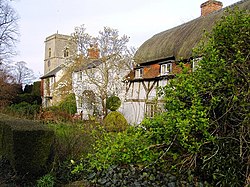 Sutton Courtenay, Berkshire | |
| Location | |
| Grid reference: | SU5094 |
| Location: | 51°38’31"N, 1°16’34"W |
| Data | |
| Population: | 2,413 (2001) |
| Post town: | Abingdon |
| Postcode: | OX14 |
| Dialling code: | 01235 |
| Local Government | |
| Council: | Vale of White Horse |
| Parliamentary constituency: |
Wantage |
| Website: | Sutton Courtenay |
Sutton Courtenay is a village in Berkshire on bank of the River Thames, two miles south of Abingdon and three miles north-west of Didcot.
Today
In the past, agriculture, a local paper mill and domestic service were the main sources of employment within the village. Now the prime employers include local scientific establishments and Didcot power station. There are many commuters using Didcot Parkway railway station to travel to London, a 45-minute journey away. Didcot Power Station itself falls within the boundaries of Sutton Courtenay parish, as do several large quarries that have been used for gravel extraction, and then used for landfill activities taking domestic refuse from London via a separate rail terminal.
History
Settlement in the parish dates from at least the Neolithic period,[1] when the alluvial plains of the Thames made the area fertile for agriculture. The Romans were here: evidence has been uncovered of a ceremonial site and road. Excavations have also revealed rough Saxon huts of the early stages of Anglo-Saxon colonization,[2] but their most important enduring monument in Sutton was the massive causeway and weirs which separate the millstream from Sutton Pools. The causeway was probably built by Saxon labour.
Written records of Sutton's history began in 688 when Ine, King of Wessex, endowed the new monastery at Abingdon with the manor of Sutton. In 801, Sutton became a royal vill,[1] with the monastery at Abingdon retaining the church and priest's house. It is believed that this was on the site of the 'Abbey' in Sutton Courtenay.
The Domesday Book of 1086 shows that the manor of 'Sudtone' was owned half by the King and farmed mainly by tenants who owed him tribute. There were three mills, 300 acres of river meadow (probably used for dairy farming) and extensive woodlands where pigs were kept.
All Saints' Church
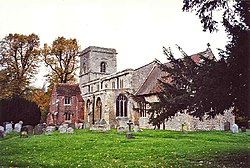
Sutton Courtenay Church as it stands today, originated in the 12th century.[3] The interior shows Norman zig-zag work and later carved capitals. On the tower door, there are crusader crosses inscribed by soldiers either hoping for or giving thanks for a safe return from the Crusades. The main south door is surrounded by a fine brick porch built with money left to the poor of the parish by the 15th-century Bishop Thomas Bekynton of Bath and Wells. The brick-built south porch also has a room above reached by a narrow stairway from inside the church. Other fittings include a 17th-century wineglass pulpit (installed in 1901), a carved mid-12th century font with fleur-de-lys pattern and three late 14th-century misericords. There is a close resemblance between the misericords at Sutton Courtenay and those created a short time afterwards at Soham in Cambridgeshire and Wingfield, Suffolk. It is possible that the same itinerant carver was responsible for all three sets. The church was nearly destroyed during the Civil War when munitions stored by the Parliamentarian vicar exploded in the church.[4][3]
Churchyard
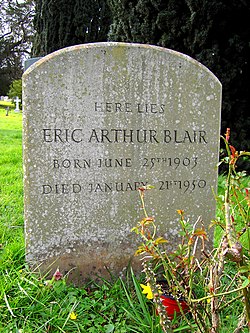
The churchyard is notable as the location of the burial place of Eric Arthur Blair, better known by his pen name, George Orwell. As a child he fished in a local stream. He lied his last years on the isle of Jura and expressed a wish to be buried in the churchyard of whichever was the nearest church to where he died, though he died in the event in London and none of the local churches had any space in their graveyards. Thinking that he might have to be cremated against his wishes, his widow asked her friends whether they knew of a church that had space for him. David Astor, a friend of Orwell's who lived in Sutton Courtenay, explained the problem to his local vicar, and arrangements were made.
The Churchyard also contains the grave of David Astor and that of Herbert Asquith, the Prime Minister. Asquith so much loved the simplicity of the village that he chose to be buried there rather than in Westminster Abbey.
Buildings of the village
Manor houses and rectory
The 'Norman Hall' is one of the oldest buildings in the village, built in about 1192[4] in the reign of King Richard I.
Across the road from the Norman Hall is The Abbey, actually the rectory house, which dates from about 1300. The 14th-century Great Hall has an arched oak roof. The manor house was formerly known as Brunce's Court when it was the home of the Brunce family, one of whom, Thomas Brunce, became Bishop of Norwich. It is a five-gabled, two-winged house which has had many additions over the centuries but originated as the great mediæval royal hall, frequented by King Henry I and then taken over by the Courtenay family, who gave their name to the village. All Saints' Church was also built at this time (see below), and is a fine example of local Norman and Mediæval architecture.
Asquith and the Wharf
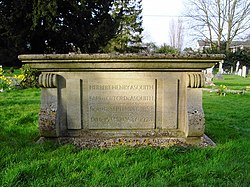
In 1912 the Prime Minister Herbert Henry Asquith chose The Wharf (which he built in 1913) and the adjoining Walton House for his country residence. Asquith and his large family spent weekends at The Wharf where his wife Margot held court over bridge and tennis. She converted the old barn directly on the river which served for accommodation for the overflow of her many weekend parties. A painting of the period by Sir John Lavery (now in the Hugh Lane Gallery in Dublin) shows Elizabeth Asquith and her young friends lounging in boats by the riverside. It was here that Asquith signed the declaration of war with the German Empire in September 1914, beginning the First World War.
Asquith and his family remained in the village after he resigned as Prime Minister and became Earl of Oxford and Asquith. He is buried in All Saints' churchyard.
References
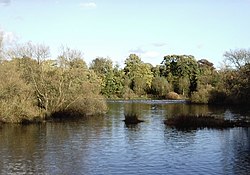
- ↑ The Drayton Cursus is half a mile to the west of Sutton Courtenay and has been dated to between 3635 and 3385 BC. Excavations in 1981/1982 also found Mesolithic artefacts.
- ↑ E.T. Leeds, in Archaeologia 73 (1922/23:147-92), 76 (1926-27:59-80; 92 (1947:79-94).
- ↑ 3.0 3.1 Ford, David Nash (2001). "Sutton Courtenay Parish Church". Royal Berkshire History. Nash Ford Publishing. http://www.berkshirehistory.com/churches/suttoncourtenay.html. Retrieved 22 January 2011.
- ↑ 4.0 4.1 Ford, David Nash (2008). "History of Sutton Courtenay, Berkshire". Royal Berkshire History. Nash Ford Publishing. http://www.berkshirehistory.com/villages/suttoncourtenay.html. Retrieved 22 January 2011.
Further reading
- Page, W.H.; Ditchfield, P.H., eds (1924). A History of the County of Berkshire, Volume 4. Victoria County History. pp. 369–379.
- Pevsner, Nikolaus (1966). Berkshire. The Buildings of England. Harmondsworth: Penguin Books. pp. 235–237.
Outside links
| ("Wikimedia Commons" has material about Sutton Courtenay) |
